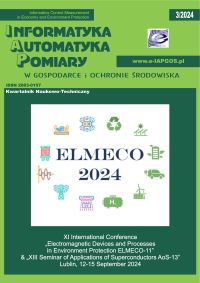POŁĄCZENIE METODY ELEMENTÓW BRZEGOWYCH I ZBIORÓW POZIOMICOWYCH W ROZWIĄZYWANIU ZAGADNIENIA ODWROTNEGO
Tomasz Rymarczyk
tomasz.rymarczyk@netrix.com.plNetrix S.A., Research and Development Center (Polska)
Paweł Tchórzewski
Netrix S.A., Research and Development Center (Polska)
Jan Sikora
Lublin University of Technology, Institute of Electronics and Information Technology; Electrotechnical Institute (Polska)
Abstrakt
Metoda elementów brzegowych i metoda zbiorów poziomicowych mogą być wykorzystane to rozwiązania zagadnienia odwrotnego pola elektrycznego. W takim podejściu równanie sprzężone jest rozwiązywane w każdym kroku iteracyjnym. Wyniki obliczeń numerycznych pokazują, że metoda elementów brzegowych może być zastosowana z powodzeniem do uzyskania przybliżonego rozwiązania równania sprzężonego. Proponowany algorytm jest inicjalizowany za pomocą topologicznej analizy wrażliwościowej. Pochodna kształtu i pochodna materialna zostały połączone z metodą zbiorów poziomicowych w celu zbadania problemów optymalizacji kształtu. Pochodna kształtu mierzy wrażliwość perturbacji brzegowych. Zespolony algorytm jest stosunkowo nową procedurą do rozwiązania tego problemu. Wyniki doświadczenia pokazały skuteczność proponowanego podejścia w rozwiązywaniu zagadnienia odwrotnego.
Słowa kluczowe:
zagadnienie odwrotne, metoda elementów skończonych, tomografia impedancyjnaBibliografia
Allaire G., Gournay F. De, Jouve F., Toader A. M.: Structural optimization using topological and shape sensitivity via a level set method, Control and Cybernetics, vol. 34, 2005, 59–80.
Google Scholar
Chen W., Cheng J., Lin W.: A level set method to reconstruct the discontinuity of the conductivity in EIT, Science in China Series A: Mathematics, vol. 52, 2009.
Google Scholar
Ito K., Kunish K., Li Z.: The Level-Set Function Approach to an Inverse Interface Problem, Inverse Problems, vol. 17, no. 5, 2001, 1225–1242.
Google Scholar
Jabłoński P.: Metoda elementów brzegowych w analizie pola elektromagnetycznego, Wydawnictwo Politechniki Częstochowskiej, 2003.
Google Scholar
Osher S., Sethian J. A.: Fronts Propagating with Curvature Dependent Speed: Algorithms Based on Hamilton-Jacobi Formulations, Journal of Computational Physics, vol. 79, 1988, 12–49.
Google Scholar
Osher S., Santosa F.: Level set methods for optimization problems involving geometry and constraints. Frequencies of a two-density inhomogeneous drum, Journal of Computational Physics, vol. 171, 2001, 272–288.
Google Scholar
Osher S., Fedkiw R.: Level Set Methods and Dynamic Implicit Surfaces, Springer New York, 2003.
Google Scholar
Rymarczyk T.: Using electrical impedance tomography to monitoring flood banks, International Journal of Applied Electromagnetics and Mechanics 45, 2014, 489–494.
Google Scholar
Rymarczyk T.: Characterization of the shape of unknown objects by inverse numerical methods, Przegląd Elektrotechniczny, R. 88, 7b, 2012, 138-140.
Google Scholar
Rymarczyk T., Sikora J., Waleska B.: Coupled Boundary Element Method and Level Set Function for Solving Inverse Problem in EIT, 7th World Congress on Industrial Process Tomography, WCIPT7, Krakow 2013.
Google Scholar
Rymarczyk:T., Adamkiewicz P., Duda K., Szumowski J., Sikora J.: New Electrical Tomographic Method to Determine Dampness in Historical Buildings, Achieve of Electrical Engineering, v.65, 2/2016, 273–283
Google Scholar
Sethian J.A.: Level Set Methods and Fast Marching Methods, Cambridge Univeristy Press, 1999.
Google Scholar
Sikora J.: Boundary Element Method for Impedance and Optical Tomography, Warsaw University of Technology Publisher, 2007.
Google Scholar
Smolik W, Forward Problem Solver for Image Reconstruction by Nonlinear Optimization in Electrical Capacitance Tomography, Flow Measurement and Instrumentation, Vol. 21, Issue 1, 2010, 70–77.
Google Scholar
Wajman R., Fiderek P., Fidos H., Jaworski T., Nowakowski J., Sankowski D., Banasiak R.: Metrological evaluation of a 3D electrical capacitance tomography measurement system for two-phase flow fraction determination; Meas. Sci. Technol. Vol. 24, 2013, No. 065302.
Google Scholar
Tai C., Chung E., Chan T.: Electrical impedance tomography using level set representation and total variational regularization, Journal of Computational Physics, vol. 205, no. 1, 2005, 357–372.
Google Scholar
Vese L., Chan T.: A new multiphase level set framework for image segmentation via the Mumford and Shah model. CAM Report 01-25, UCLA Math. Dept., 2001.
Google Scholar
Autorzy
Tomasz Rymarczyktomasz.rymarczyk@netrix.com.pl
Netrix S.A., Research and Development Center Polska
Autorzy
Paweł TchórzewskiNetrix S.A., Research and Development Center Polska
Autorzy
Jan SikoraLublin University of Technology, Institute of Electronics and Information Technology; Electrotechnical Institute Polska
Statystyki
Abstract views: 258PDF downloads: 65
Licencja

Utwór dostępny jest na licencji Creative Commons Uznanie autorstwa – Na tych samych warunkach 4.0 Miedzynarodowe.
Inne teksty tego samego autora
- Tomasz Rymarczyk, ALGORYTMY TOPOLOGICZNE DO ROZWIĄZYWANIA ZAGADNIENIA ODWROTNEGO W TOMOGRAFII ELEKTRYCZNEJ , Informatyka, Automatyka, Pomiary w Gospodarce i Ochronie Środowiska: Tom 7 Nr 1 (2017)
- Tomasz Rymarczyk, Przemysław Adamkiewicz, TOMOGRAFIA IMPEDANCYJNA DO WYZNACZANIA WILGOTNOŚCI W MODELU WAŁU , Informatyka, Automatyka, Pomiary w Gospodarce i Ochronie Środowiska: Tom 7 Nr 1 (2017)
- Maciej Pańczyk, Jan Sikora, MODYFIKACJE METODY ELEMENTÓW BRZEGOWYCH ZASTOSOWANE W WYBRANYCH ASPEKTACH TOMOGRAFII IMPEDANCYJNEJ I OPTYCZNEJ , Informatyka, Automatyka, Pomiary w Gospodarce i Ochronie Środowiska: Tom 7 Nr 1 (2017)
- Tomasz Rymarczyk, Paweł Tchórzewski, Jan Sikora, WYKRYWANIE SZCZELIN POWIETRZNYCH W CHODNIKU KOPALNI MIEDZI ZA POMOCĄ ELEKTRYCZNEJ TOMOGRAFII IMPEDANCYJNEJ , Informatyka, Automatyka, Pomiary w Gospodarce i Ochronie Środowiska: Tom 7 Nr 1 (2017)
- Konrad Kania, Tomasz Rymarczyk, METODY DO ANALIZY DETEKCYJNEJ W SYSTEMIE KONTROLI JAKOŚCI , Informatyka, Automatyka, Pomiary w Gospodarce i Ochronie Środowiska: Tom 8 Nr 3 (2018)
- Tomasz Rymarczyk, ZBIORY POZIOMICOWE I ALGORYTMY INTELIGENCJI OBLICZENIOWEJ DO ANALIZY OBRAZÓW MEDYCZNYCH W SYSTEMIE E-MEDICUS , Informatyka, Automatyka, Pomiary w Gospodarce i Ochronie Środowiska: Tom 7 Nr 1 (2017)
- Paweł Tchórzewski, ZASTOSOWANIE METODY ELEMENTÓW BRZEGOWYCH DO ROZWIĄZYWANIA PROBLEMÓW PROSTYCH W OBSZARACH STREFOWO NIEJEDNORODNYCH WZGLĘDEM PRZEWODNICTWA WŁAŚCIWEGO , Informatyka, Automatyka, Pomiary w Gospodarce i Ochronie Środowiska: Tom 5 Nr 3 (2015)
- Tomasz Rymarczyk, Jan Sikora, ROZPRASZANIE PRZEZ PUSTE PRZESTRZENIE KOŁOWE ZE SZTYWNĄ GRANICĄ: PROSTE I ODWROTNE ZAGADNIENIA DLA OBSZARÓW OTWARTYCH I ZAMKNIĘTYCH , Informatyka, Automatyka, Pomiary w Gospodarce i Ochronie Środowiska: Tom 12 Nr 4 (2022)








